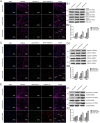Honokiol exerts protective effects on neural myelin sheaths after compressed spinal cord injury by inhibiting oligodendrocyte apoptosis through regulation of ER-mitochondrial interactions
- PMID: 33830903
- PMCID: PMC9246194
- DOI: 10.1080/10790268.2021.1890878
Honokiol exerts protective effects on neural myelin sheaths after compressed spinal cord injury by inhibiting oligodendrocyte apoptosis through regulation of ER-mitochondrial interactions
Abstract
Objective: To investigate the effect of honokiol on demyelination after compressed spinal cord injury (CSCI) and it's possible mechanism.
Design: Animal experiment study.
Setting: Institute of Neuroscience of Chongqing Medical University.
Interventions: Total of 69 Sprague-Dawley (SD) rats were randomly divided into 3 groups: sham group (n=15), honokiol group (n=27) and vehicle group (n=27). After established CSCI model by a custom-made compressor successfully, the rats of sham group were subjected to the limited laminectomy without compression; the rats of honokiol group were subjected to CSCI surgery and intraperitoneal injection of 20 mg/kg honokiol; the rats of vehicle group were subjected to CSCI surgery and intraperitoneal injection of an equivalent volume of saline.Outcome measures: The locomotor function of each group was assessed using the Basso, Beattie and Bresnahan (BBB) rating scale. The pathological changes of myelinated nerve fibers of spinal cord in 3 groups were detected by osmic acid staining and transmission electron microcopy (TME). Immunofluorescence and Western blot were used to research the experessions of active caspase-3, caspase-12, cytochrome C and myelin basic protein (MBP) respectively.
Results: In the vehicle group, the rats became paralyzed and spastic after injury, and the myelin sheath became swollen and broken down along with decreased number of myelinated nerve fibers. Western blot analysis manifested that active caspase-3, caspase-12 and cytochrome C began to increase 1 d after injury while the expression of MBP decreased gradually. After intervened with honokiol for 6 days, compared with the vehicle group, the locomotor function and the pathomorphological changes of myelin sheath of the CSCD rats were improved with obviously decreased expression of active caspase-3, caspase-12 and cytochrome C.
Conclusions: Honokiol may improve locomotor function and protect neural myelin sheat from demyelination via prevention oligodendrocytes (OLs) apoptosis through mediate endoplasmic reticulum (ER)-mitochondria pathway after CSCI.
Keywords: Compressed spinal cord injury; Demyelination; Honokiol; Oligodendrocyte; Remyelination.
Figures




Similar articles
-
Demyelination initiated by oligodendrocyte apoptosis through enhancing endoplasmic reticulum-mitochondria interactions and Id2 expression after compressed spinal cord injury in rats.CNS Neurosci Ther. 2014 Jan;20(1):20-31. doi: 10.1111/cns.12155. Epub 2013 Aug 13. CNS Neurosci Ther. 2014. PMID: 23937638 Free PMC article.
-
p53-Mediated oligodendrocyte apoptosis initiates demyelination after compressed spinal cord injury by enhancing ER-mitochondria interaction and E2F1 expression.Neurosci Lett. 2017 Mar 22;644:55-61. doi: 10.1016/j.neulet.2017.02.038. Epub 2017 Feb 24. Neurosci Lett. 2017. PMID: 28237798
-
Protective Effect of Electroacupuncture on Neural Myelin Sheaths is Mediated via Promotion of Oligodendrocyte Proliferation and Inhibition of Oligodendrocyte Death After Compressed Spinal Cord Injury.Mol Neurobiol. 2015 Dec;52(3):1870-1881. doi: 10.1007/s12035-014-9022-0. Epub 2014 Dec 4. Mol Neurobiol. 2015. PMID: 25465241
-
[Effect of electroacupuncture combined with Schwann cell transplantation on limb locomotor ability, regional remyelination and expression of spinal CD4 and CD8 proteins in compressive spinal injury rats].Zhen Ci Yan Jiu. 2019 Jun 25;44(6):391-8. doi: 10.13702/j.1000-0607.180780. Zhen Ci Yan Jiu. 2019. PMID: 31368260 Chinese.
-
AMX0035 Mitigates Oligodendrocyte Apoptosis and Ameliorates Demyelination in MCAO Rats by Inhibiting Endoplasmic Reticulum Stress and Mitochondrial Dysfunction.Int J Mol Sci. 2025 Apr 19;26(8):3865. doi: 10.3390/ijms26083865. Int J Mol Sci. 2025. PMID: 40332557 Free PMC article.
Cited by
-
Neuropharmacological potential of honokiol and its derivatives from Chinese herb Magnolia species: understandings from therapeutic viewpoint.Chin Med. 2023 Nov 24;18(1):154. doi: 10.1186/s13020-023-00846-1. Chin Med. 2023. PMID: 38001538 Free PMC article. Review.
-
Honokiol ameliorates reserpine-induced fibromyalgia through antioxidant, anti-inflammatory, neurotrophic, and anti-apoptotic mechanisms.Sci Rep. 2025 Jul 17;15(1):25983. doi: 10.1038/s41598-025-07209-w. Sci Rep. 2025. PMID: 40676048 Free PMC article.
-
Compound from Magnolia officinalis Ameliorates White Matter Injury by Promoting Oligodendrocyte Maturation in Chronic Cerebral Ischemia Models.Neurosci Bull. 2023 Oct;39(10):1497-1511. doi: 10.1007/s12264-023-01068-z. Epub 2023 Jun 9. Neurosci Bull. 2023. PMID: 37291477 Free PMC article.
-
The Neolignan Honokiol and Its Synthetic Derivative Honokiol Hexafluoro Reduce Neuroinflammation and Cellular Senescence in Microglia Cells.Cells. 2024 Oct 4;13(19):1652. doi: 10.3390/cells13191652. Cells. 2024. PMID: 39404415 Free PMC article.
-
Myelin sheath injury and repairment after subarachnoid hemorrhage.Front Pharmacol. 2023 Apr 3;14:1145605. doi: 10.3389/fphar.2023.1145605. eCollection 2023. Front Pharmacol. 2023. PMID: 37077816 Free PMC article. Review.
References
-
- Barateiro A, Fernandes A.. Temporal oligodendrocyte lineage progression: in vitro models of proliferation, differentiation and myelination. Biochim Biophys Acta 2014;1843(9):1917–29. - PubMed
Publication types
MeSH terms
Substances
LinkOut - more resources
Full Text Sources
Other Literature Sources
Medical
Research Materials
Miscellaneous
